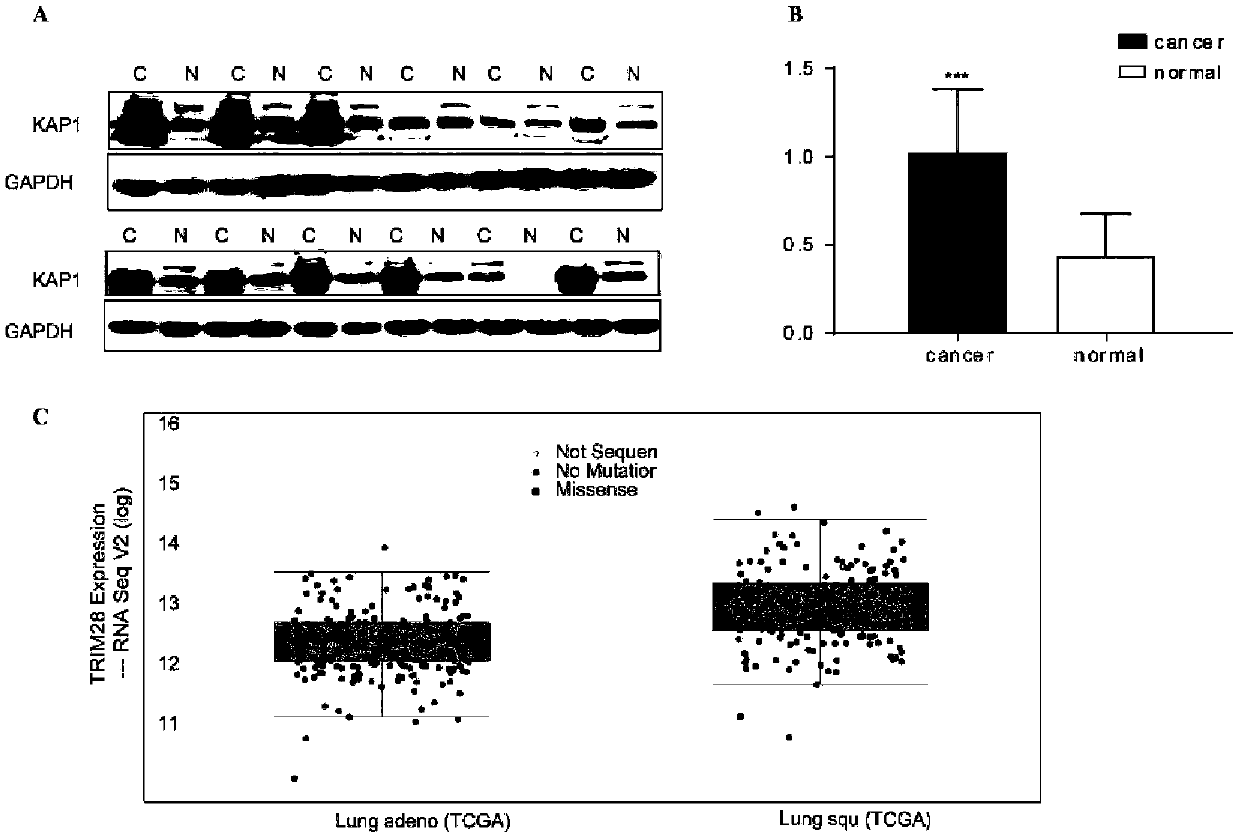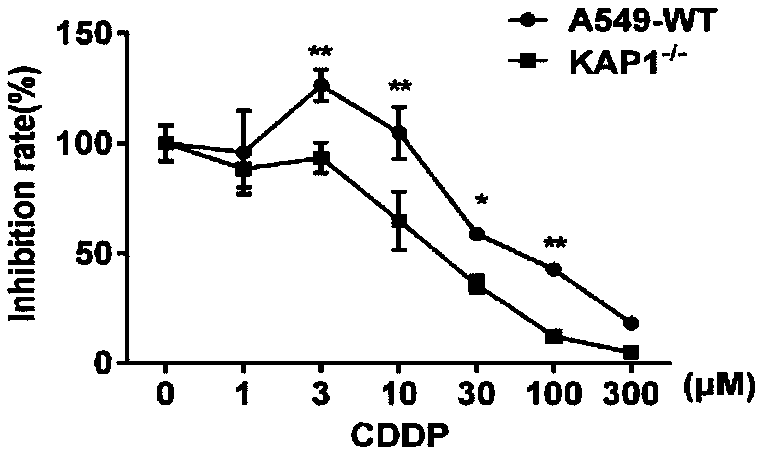Inhibitor for targeted therapy of lung cancer, application of inhibitor as well as application of KAP1 as drug target in screening of anti-lung cancer drugs
An anti-lung cancer drug and targeted therapy technology, applied in the field of biomedicine, can solve problems such as strong toxic and side effects of drugs, poor treatment effect, and adverse reactions.
- Summary
- Abstract
- Description
- Claims
- Application Information
AI Technical Summary
Problems solved by technology
Method used
Image
Examples
Embodiment 1
[0057] Lung cancer tissues and adjacent normal tissues from 30 patients with non-small cell lung cancer in the Thoracic Surgery Department of the First People's Hospital of Yunnan Province were selected as test samples.
[0058] The tumor tissue and paracancerous tissue were put into different cryopreservation tubes, directly stored in liquid nitrogen, and stored in dry ice during transportation. To lyse cells, take a tissue block the size of a grain of rice, wash the blood stains of the tissue block with ice-cold PBS solution, remove excess liquid, and add 200 μL of RIPA lysate containing protease inhibitors. Use a tissue grinder to grind the tissue in a 1.5mL centrifuge tube. During the grinding process, do not leave the ice. Pause for 10 seconds every 5 seconds to prevent the tissue from overheating and destroying the integrity of the protein. It is completely normal that some connective tissue cannot be ground. After grinding, the solution was placed on ice for half an ho...
Embodiment 2
[0073] Plasmid construction
[0074] 1: Design and synthesis of gRNA
[0075] Design gDNA sequence
[0076] To design a pair of gDNA of about 20bp, we can design through the following online tools:
[0077] CRISPRDesign at MIT: http: / / crispr.mit.edu /
[0078] Design the gRNA sequence targeting the gene encoding KAP1, as shown in the following table:
[0079] Table 1 gRNA-KAP1 nucleic acid sequence
[0080]
[0081] Note: The lowercase part is the nucleic acid sequence connected to the plasmid, and the uppercase part is the gRNA sequence
[0082] 2: Cloning sgRNA into pSpCas9(BB) plasmid
[0083] (I) Each gRNA was dissolved to a final concentration of 100 μM, and the sgRNA was phosphorylated and annealed according to the following recipe.
[0084] Element
Dosage (ul)
sgRNA forward sequence (100uM)
1
sgRNA reverse sequence (100uM)
1
T4 ligation buffer 10X
1
T4PNK
1
water
6
Total
10
[...
Embodiment 3
[0111] Cell Proliferation:
[0112] 1. Observe the cells under a microscope. When the confluence of the A549-KAP1-KO cells prepared in Example 2 reaches 80% to 90%, discard the medium, add PBS solution to gently rinse, and discard the rinse solution.
[0113] 2. After adding a certain amount of trypsin, put the cells in 37°C, 5% CO 2 Put it in the cell culture incubator for about 3 minutes, then take it out and observe it under the microscope until the cells become round, then add 10% fetal bovine serum medium into the ultra-clean workbench to stop the digestion, and use a pipette to blow back and forth to break up the cells .
[0114] 3. Cell counting: take the hemocytometer, make sure it is clean, you can wipe it with alcohol, cover the cover glass on the hemocytometer, and cover the area with small squares on the hemocytometer. Use a micropipette to take 10 μL of the cell suspension and inject it from one end of the hemocytometer into the hemocytometer tank. Due to capill...
PUM
 Login to View More
Login to View More Abstract
Description
Claims
Application Information
 Login to View More
Login to View More - R&D Engineer
- R&D Manager
- IP Professional
- Industry Leading Data Capabilities
- Powerful AI technology
- Patent DNA Extraction
Browse by: Latest US Patents, China's latest patents, Technical Efficacy Thesaurus, Application Domain, Technology Topic, Popular Technical Reports.
© 2024 PatSnap. All rights reserved.Legal|Privacy policy|Modern Slavery Act Transparency Statement|Sitemap|About US| Contact US: help@patsnap.com










